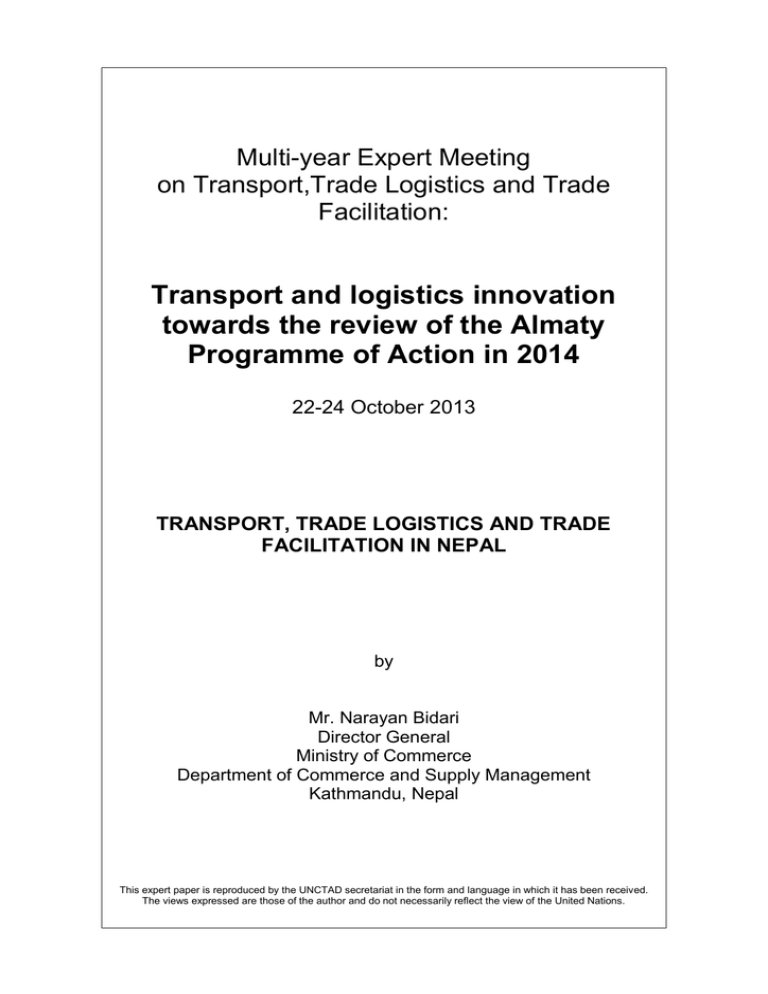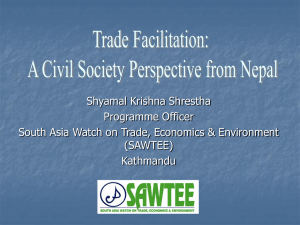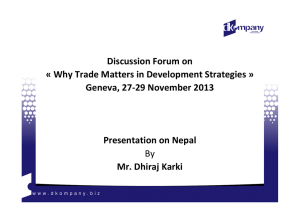Transport and logistics innovation towards the review of the Almaty
advertisement

Multi-year Expert Meeting on Transport,Trade Logistics and Trade Facilitation: Transport and logistics innovation towards the review of the Almaty Programme of Action in 2014 22-24 October 2013 TRANSPORT, TRADE LOGISTICS AND TRADE FACILITATION IN NEPAL by Mr. Narayan Bidari Director General Ministry of Commerce Department of Commerce and Supply Management Kathmandu, Nepal This expert paper is reproduced by the UNCTAD secretariat in the form and language in which it has been received. The views expressed are those of the author and do not necessarily reflect the view of the United Nations. 11/4/2013 Transport, Trade Logistics and Trade Facilitation Activities In Nepal. Presentation by Narayan Prasad Bidari Director General Department of Commerce and Supply Management, GoN Babar Mahal, Kathmandu. 22-24 October, 2013 Presentation Outline • Nepal in Global Trade • Nepal’s progress review in light of Almaty programme of Action • Major Policy Reforms in Trade Sector • Transit and Transport : A brief overview • Trade Logistics : Accomplishments and challenges • Trade Facilitation : Major Initiatives and Challenges • Key findings and lessons learned for future interventions fi 2 1 11/4/2013 Fiscal Year Total Export 2004/05 58.44 Yearly Total Chang Import e Rate (%) 8.3 148.29 (28.26%) Yearly Chang e Rate (%) Total Yearly Foreign Change Trade Rate Trade Deficit 9.2 (%) 206. 74 8.9 89.85 Yearly Change Rate (%) 9.7 Export/ Import Ratio 1:2.5 (71.72%) 2008/09 68.60 (19%) 17.3 291.00 (81%) 22.8 359.60 21.7 222.40 24.6 1:4.2 2009/10 60.95 (14%) -11.1 375.61 (86%) 29.1 436.56 21.4 314.66 41.5 1:6.2 2010/11 64.56 (14%) 5.9 397.54 (86%) 5.8 462.10 5.9 332.98 5.8 1:6.2 2011/12 74.09 (12.9) 14.8 498.16 (87.1%) 25.3 572.25 23.8 424.07 27.4 1:6.7 2012/13 77.35 (11.4) 4.4 601.21 (88.6%) 20.7 678.56 523.86 23.5 1:7.8 18.6 GDP Trade Ratio Fiscal Years 04/ 05 05/06 Total Trade /GDP 35.3 Total Export /GDP 06/ 07 07/08 09/ 10 10/ 11 11/ 12 35.8 34.9 34.5 35.6 36.5 33.6 34.4 33.0 10.0 9.2 5.1 4.7 4.8 Total Import/ GDP 25.4 26.6 26.8 27.2 28.8 31.4 18.9 29.6 29.0 Trade Deficit/ GDP -15.4 -17.4 -18.6 -19.9 - 21.9 - 26.3 -24.2 -24.9 -24.9 8.2 7.3 08/09 6.9 12/ 13 4.00 2 11/4/2013 Nepal’s Trade Performance 800 Nepal Completed its first TPR Nepal became WTO Member 600 400 Total Trade Total Import Total Export Trade Defict NRs. in Billion 200 0 2003/04 2004/05 2005/06 2006/07 2007/08 2008/09 2009/10 2010/11 2011/12 -200 -400 -600 5 year Nepal's Top ten Major Export Item in the Year 2012/13 (Nrs. in billion) S.No 1 2 3 4 5 6 7 8 9 10 11 Particular Irion and Steel Yarn (Polyester, cotton and others) Woolen Carpet Textiles Cardamom Readymade Garments Juice Lentils Jute bags and sacks Woolen and Pashmina Shawls Tea Total Value 11.64 5.83 5.66 5.40 3.85 3.82 3.81 2.68 2.54 2.18 2.00 49.41 Share of major 11 export items in total export (major10-11 items occupy almost 2/3 of export value) % change +2.8 -7.7 -5.7 +3.5 +10.1 -5.82 +23.9 0 +8.7 14.2 29.8 64% 6 3 11/4/2013 Nepal's Top Ten Major Import Items in the Year 2012/13 (Nrs. in billion) S.No Particular 1 Petroleum Products 2 Value % change 111.13 +14.5 Iron & Steel & Products therof 57.41 +15.6 3 Transport Vehicles and parts thereof 32.30 +35.1 4 Machinery and Parts 33.44 +27 5 Gold 26.00 0.9 6 Electronic and Electrical Equipments 23.37 +9.7 7 Cereals 20.92 +56 8 Fertilizers 16.48 +73.4 9 Pharmaceutical Products 15.21 +10.9 10 Telecommunication Equipment and Parts 14.00 +23.9 Total Share of Major 10 import item in total import 350.26 58.27 7 Major Trading Partners of Nepal (2012/13) Export Rank Country 1 2 India USA 3 4 Germany Banglades h China P.R. 5 Import Value Percenta Country Value in Percentag in Nrs. ge Nrs. e Share Billion Share Billion 51.8 67% India 398 66% 5.7 7.0% China P.R. 68.3 11.36% 2.8 2.7 3.6% UAE 3.52% Indonesia 2.18 2.81% Thailand Total 84% 37.22 9.6 6.1% 1.59% 9.4 1.57% Total 86.62 8 4 11/4/2013 Nepal in The Global Trade The growth rate of trade is much faster/tremendous than the GDP growth rate (in FY. 2012/13 GDP growth was 3.5% while trade growth was much bigger, almost 5 times. Nepal has trade transactions with more than 180 countries. However almost two third trade occurs with India (65%) , China occupies second (10%) position and rest of the world occupies around 25% share of Nepal’s trade. According to Doing Business Report-2013, Nepal ranked 108th position out of 185 countries. (degraded by 1 rank , compared to previous year) 9 Economy Ranking- Ease of Doing Business, 2013 S.No. Indicators 1 Starting Business 2 Dealing with Construction Permits 3 Getting Electricity 4 Registering Property 5 Getting Credit 6 Protecting Investors 7 Paying Taxes 8 Trading Across Borders 9 Enforcing Contracts 10 Resolving Insolvency Monday, November 04, 2013 Ranking 105 97 96 21 70 82 114 171 137 121 10 5 11/4/2013 Trading Across Boarders in Nepal, 2013 Trading Across Boarder (Nepal) DB Rank Cost to Export (US $ per Container) Cost to Import (US $ per Container) Documents to Export (number) Documents to Import (number) Time to Export (days) Nepal South Asia Ave. OECD Ave. 171 1975 1603 1028 2095 1736 1080 11 8 4 11 9 5 41 32 10 Time to Import (days) 38 33 10 Monday, November 04, 2013 11 Details on Trading Across Boarders in Nepal Nature of Export Procedures Document Preparation Customs Clearance and Technical Control Ports and Terminal Handling Inland Transportation and Handling Total Monday, November 04, 2013 Duration US $ Cost (days) 14 4 300 300 4 275 19 1,100 41 $ 1975 12 6 11/4/2013 Details on Trading Across Boarders in Nepal Nature of Import Procedures Document Preparation Customs Clearance and Technical Control Ports and Terminal Handling Inland Transportation and Handling Total Duration US $ Cost (days) 14 5 270 300 6 275 13 1,250 38 $ 2095 Monday, November 04, 2013 13 Monday, November 04, 2013 14 7 11/4/2013 Objectives and Relevance of Almaty of Action for LLDCs • The Almaty Programme of Action is a masterpiece document for LLDCs adopted in August, 2003 by the International Ministerial Conference of Landlocked and Transit Developing Countries, Donor Countries and International Financial and Development Institutions on Transit Transport Cooperation. • UN-OHRLLS in February, 2004 prepared the Road Map for the implementation of the APA • The overarching goal of the APP is to address the special needs of landlocked developing countries and establish a new global framework for action for developing efficient transit transport systems in landlocked and transit developing countries, taking into account the interests of both landlocked and transit developing countries. • APP’s ultimate goal is to help LLDCs better integrate into the world economy and take due economic advantage thereof through Monday, November 04, 2013 15 reducing transit and transport related cost. Objectives of the APP The Programme of Action mainly aims to: (a) securing access to and from the sea by all means of transport (b) reducing costs and improve services so as to increase the competitiveness of LLDCs’ exports; (c) reducing the costs of imports; (d) addressing problems of delays and uncertainties in trade routes; (e) developing adequate national networks; (f) reducing loss, damage and deterioration en route; (g) open the way for export expansion; (h) improving safety of road transport and security of people along the corridors. Monday, November 04, 2013 16 8 11/4/2013 Five Prioritized Areas of Interventions 1. Fundamental Transit Policy Issues 2. Infrastructural Development and Maintenance 2.1 Rail Transport 2.2 Road Transport 2.3 Ports 2.4 Inland Waterways 2.5 Pipelines 2.6 Air Transport 2.7 Communications 3. International Trade and Trade Facilitation 4. International Support Measures 5. Implementation and Review Monday, November 04, 2013 17 Nepal’s Efforts to Implement APA 1. As a LLDC Nepal fully acknowledges APP as an important document agreed in international level and is fully committed to implement APA to the best of its capacity. 2. Some of the activities proposed in road map of APA are internalized, incorporated and endorsed in national development plans, Trade Policy, 2009 and NTIS, 2010. 3. Trade has been recognized as engine of growth and mainstreamed into national development plan, policies. 4. Government is committed to develop trade related infrastructures and mobilizing foreign resources to develop trade infrastructures such as Inland Clearance Depot (ICDs), Customs Modernization etc. 5. GoN prepared and submitted National Assessment Report on the Implementation of Almaty Programme of Action in February, 2013. Also conducted TF need assessment primarily. 6. Nepal is participating review, follow up and consultation meeting regularly relating to APA. Monday, November 04, 2013 18 9 11/4/2013 A Brief Review of Adopted Policy Measures 1. 2. In the last one decade, Nepal undertook several policy and institutional reforms with a view to promote trade, reducing trade cost and ensuring transit. Most of the reforms are in line with APA. The major reforms/initiatives undertaken during this period include : Joining the WTO in April, 2004 and embarking on SAFTA and BIMSTEC RTA, Following the WTO membership almost 2 dozens acts/regulations either amended or introduced in new form (such as Customs Act and Regulation, Public Procurement Act, Industrial Policy, Trade Policy, ) Customs Offices have been modernized and process related to customs are on way to harmonization, simplification and standardization. A high level Investment Board constituted under the Prime Minister’s Chairmanship with the introduction of Board Investment Act, 2011. Nepal Inter-Modal Transport Development Committee established, Bilateral Investment Promotion and Protection Agreement, Double Taxation Avoidance Agreement are concluded with several countries Country’s First Trade Policy Review, in the WTO completed in March, 2012. 3. Compared to the exhaustive list of policy/institutional reforms, results are moderate Monday, November 04, 2013 19 A Brief Overview of Infrastructural Reforms • Constrained capacity and limited resource did not allow country to lunch mega projects in a large- scale in trade sector development. However, some of the big infrastructures supportive to trade, built during the last decade can be listed as follows : - Construction of 4 ICDs (one is rail linked while rest 3 is road linked) in southern border and one ICD being constructed in north border. - One international airport and around 3 dozens of domestic airport with modest facilities are into operation. - Construction of one Special Economic Zone in south western part of the country. - Opening up track of Mid-hill Highway across the country is underway. - No brad gage railway line available so far, however with the establishment of Railway Department in recent years, railway planning at country level kicked off. - No inland water ways are available nor any pipeline to supply gas or petroleum product constructed. However, a concept of building a pipeline to supply petroleum products between Indian Border (Raxaul) to Nepal Boarder (Amlekhgung) is under consideration in recent years. • Financial and technical constraints coupled with political transition has crippled infrastructure building process to a large extent. - Monday, November 04, 2013 20 10 11/4/2013 Institutional Reforms in Trade and Transport Facilitation Sector – Board of Trade, established under Hon’ble Commerce Minister as envisaged by Trade Policy, 2009 is the Apex body to provide overall policy guidance in trade sector. – Transport Facilitation Committee established in 1994, to support and guide Multi-Modal Project. – Multi-modal Project was launched in full fledged in 2001 for transport facilitation activities. – High Level Committee “Nepal Trade and Transport Facilitation Committee (NTTFC)” was established on 2012, under the Chairmanship of Commerce Secretary comprising key stakeholders from public and private sector. 21 Composition of NTTFC • • • • • • • • • • • • • • • • • • • Secretary, MoCS Chairpersons Joint Secretary, MoC Member Joint Secretary, MoF Member Joint Secretary, MoAD Member Joint Secretary, MoIDT Member Joint Secretary, MoUD Member Joint Secretary, MoI Member Joint Secretary, MoCS Member Director General, DoCSM Member Director General, DoC Member President, FNCCI Member President, CNI Member President, NEFA Member President, Chamber of Commerce Member President , Nepal Transport and Warehouse Com. Ltd. Member ED, NITBD Member ED, TEPC Member Director, NRB Member Under Secretary, MoCS Member Secretary 22 11 11/4/2013 NTTFC’s Main Objectives and Focused Areas: • Main Objectives – – – – To suggest on policy reform, To assist in implementing such reform initiatives, To co-ordinate with public and private institution. To monitor trade initiatives and to recommend new policy measures to facilitate trade. • NTTFC’s Focused Areas – – – – In house reform activities Customs (Border Point) process simplification Coordination and management border issues, Facilitation trade and transit projects ex. Nepal India Regional Trade and Transport Project (NIRTTP) 23 Special Functions of NTTFC – Review of legal provision and procedure and suggest of simplification and harmonization to achieve the trade facilities – Establish better coordination through dialogue among trade and transport related agencies. – Provide policy feedback for advancement of trade, transport and facilitation at sub-regional and regional level. – Identified the major road blocks in improvement of transport system in general and intermodel transport linkages. – Undertake coordination of activities related to facilitation of international trade, transport and transit, particularly transit procedure, introducing of National Single Window, Addressing SPS and TBT barriers and streamlining export and imports procedure – Pursue efforts on simplification, standardization and harmonization of trade and transit document. – Promote training and research in international trade transit and transport and upgrade common knowledge of the stakeholders on the international practice. – Promote the adoption of standard trade and transport terminology and particular use of terms by the Nepalese trading communities . – Help and mobilize the trade related technical assistance and aid for trade and transport facilitation. – Increase public awareness on trade facilitation measures, practices and standards, and 24 12 11/4/2013 Trade Facilitation Activities in Nepal • Trade Facilitation has become a key area of trade reform in Nepal for long; • The scope of Trade Facilitation reform in Nepal has included from the first generation of trade reforms – i.e. easing of border restrictions to merchandise trade, to the new generation of trade facilitation - trade related institutional and regulatory reforms. • Nepal implemented first phase of Customs Reforms and Modernization project and now in the stage of implementing 2nd phase. • Of the 39 measures, as proposed in TF draft agreement, 8 are fully implemented, 24 are being partially implemented, 5 are not implemented and 2 are not applicable to Nepal. Monday, November 04, 2013 25 TF Measures in Nepal • Publication: Most of the trade & transit related information are published both in hard copy and electronic copy. They are also put in website of concerned agencies and updated as extent possible. • Enquiry Points: Ministry of Commerce and Supplies, Department of Customs, Department of Food Technology and Quality Control and Nepal Bureau of Standards and Metrology have established enquiry points to facilitate traders in their concerned regime; Monday, November 04, 2013 26 13 11/4/2013 TF Measures in Nepal • Interval between Publication and Entry into Force: there is not any mandatorily established practice to maintain such a gap; Generally some interval is maintained between the publication and entry into force of the law. • Opportunity to comment on New and Amended Rules: Good opportunity is provided to comment on new and amended laws. It is done in various stages from drafting to finalizing. Consultation is done through the concerned agency, regular committee on the Cabinet and the Parliament; Monday, November 04, 2013 27 TF Measures in Nepal • Consultation: The concerned government agencies enter into consultations with border agencies and traders on the harmonization of procedures, documentation and application of new laws and regulations; A separate ‘Trade Facilitation Committee’ (TFC) chaired by Director General, the head of Department of Customs, has been created to hold consultations with stakeholders and sort out problems for the expeditious clearance and facilitation at customs. • Advance Rulings: Current Customs Act has a provision of advance ruling only on HS commodity classification of a product. But there is not any provision of advance ruling in other areas including duty drawback, rules of origin and Customs valuation. Monday, November 04, 2013 28 14 11/4/2013 TF Measures in Nepal • Right to Appeal: the relevant legislations, including the Customs, Export and Import and Foreign Exchange, have clearly established the right to appeal in trade related matters. In most of the cases, the semi-judicial or judicial bodies heard the appeal. Main features of appeal mechanism includes nondiscriminatory, easily accessible established procedures, reasons to be assigned in each decision and right to representation by an independent counsel. • Notification for enhanced controls or inspections: Food products not meeting the food standards are not allowed to enter into the country. In addition the government issues an import alert notification on occasions to safeguard the human, animal and plant health. The system is adopted only in cases of contaminated food products. • Export and Import (Control) Act 1957 lays down conditions that included import surge and public health grounds under which the Government can prohibit or control or apply full or quantitative restriction on exportation or importation of any goods with or without specifying any specific condition or period. Monday, November 04, 2013 29 TF Measures in Nepal • Detention: The respective Customs offices generally inform the importer or their authorized agent when goods are detained for testing and verification. • Test Procedures: There are basic testing facilities at major border points especially in relation to food products. Testing procedures and validated methods are in place along with accreditation of labs. Testing procedure adopted by NBSM is as per ISO/IEC 17025. The quarantine administrations are being operated as per IPPC, OIE and Codex. Monday, November 04, 2013 30 15 11/4/2013 TF Measures in Nepal • Pre-arrival processing: Nepal allows pre-arrival of processing of documents with Customs with a view to allowing an importer to pay customs duties in advance of goods arrival. Such goods will be cleared immediately upon arrival. • E-Payment: Nepal has not been able to establish epayment system for duties, taxes, fees and charges collected by customs. • Separation of Release from the Final Determination and Payment of Duties and Charges: The facility is currently made available in few cases like import of raw materials and dispute in goods valuation. Monday, November 04, 2013 31 TF Measures in Nepal • Risk Management: Currently, risk management is being used in 6 main Customs offices that represent altogether about 60% of total trade and 90% of customs revenue. With the application of the risk management, it is estimated about 30% to 40% consignments are being cleared without physical verification at those Customs. DOC is in process of gradually expanding risk management to other Customs in due course of time. • Post-Clearance Audit: Though the PCA used to be conducted by the concerned Customs offices and DOC till FY 2008/09, a separate office cell was established in October 2009; Customs law guarantee PCA can be conducted until 4 years from the date of clearance. • Authorized Operators: There is not any legal and administrative provisions of Authorized Operators in Nepal. Monday, November 04, 2013 32 16 11/4/2013 TF Measures in Nepal • Expedited Shipments: There is no legal provision or administrative arrangement to practice separate procedures for expedited shipments. • Prohibition of Consular Transaction Requirements: There is not any consular transaction requirement in Nepal. • Border Agency Cooperation: Though each of the relevant border agencies has its own individual activities and requirements, they generally cooperate with each other in risk analysis of consignments and documentary requirements. Similarly coordination and cooperation at cross border Customs have also been established through regular consultations and meetings. Monday, November 04, 2013 33 TF Measures in Nepal • Formalities and Documentation Requirements: Import and export documentation and requirements are reviewed as and when required to ensure compliance with policy objectives and technological changes. • Acceptance of Copies: Mostly original documents are preferred though in some cases copy documents authenticated by the holder of the original are also accepted. Nepal does not need an original of the export declaration issued by the authorities in the place of origin/shipment for the purpose clearance of imports. • Use of International Standards: Standards as required under WTO Agreements and other international agreements to which Nepal is party are in the course of gradual application as the basis for its import, export and transit procedures. Monday, November 04, 2013 34 17 11/4/2013 TF Measures in Nepal • Single Window: Nepal does not yet have established Single Window system. But it has initiated to introduce it and conducted a feasibility study. • Pre-Shipment Inspections: There is not any mandatory requirement for the both pre-shipment and post – shipment inspection. • Use of Customs Brokers: There is no mandatory use of Customs brokers. Traders can directly deal with Customs through their proprietor, partner or CEO. But a trader cannot appoint other representatives to clear the goods on their behalf other than the mentioned above. Monday, November 04, 2013 35 TF Measures in Nepal • Common Border Procedures and Uniform Documentation Requirements: common clearance procedures including standards, fees & charges, specifications, terminologies & definitions, inspection, sampling and test methods are applied without any discrimination at all exit and entry Customs points of the same nature. • Rejected Goods: There is a provision of returning rejected goods to the exporter provided that the importer submits a guarantee to the Customs to bring back payments made in foreign currency within a reasonable time. • Inward and Outward Processing: Customs Law allows temporary imports and exports for repair purposes against a bank guarantee of 0.5 percent of value for aircraft or helicopters or their parts, and 5 percent of value for other goods. Monday, November 04, 2013 36 18 11/4/2013 TF Measures in Nepal • Freedom of Transit: The bilateral transit treaty with India includes provisions for Nepal-to-Nepal via India movement of goods. • Customs law provides for duty free movement of Nepal-to-Nepal via foreign land (India or TAR), and foreign-to-foreign (India-to-India or TAR-to-TAR) via Nepal or traffic-in-transit respectively. • Nepalese land is not being regularly used as a transit point/route for importation and exportation of goods by other countries except on a very few occasions in the past. • For instance, Nepal as a transit route has provided the transit facility to TAR for third country imports via the TIA Customs Office in the past. • No taxes and fees except service charges are levied on such transit traffic. • In respect of using transit route by Nepal, the bilateral transit treaty and Rail Services Agreement (RSA) with India govern the transit procedures, documentation, mode and route of transport, border entry/exit Customs and gateway seaport for sea voyage. Monday, November 04, 2013 37 TF Measures in Nepal • • • • • • • Nepal also has entered into a bilateral transit agreement with Bangladesh that lays down transit procedures, documentation, gateway ports, and mode of transport and entry/exit points at Bangladesh-India border. As per the provisions of the bilateral transit treaty with India, the Intergovernmental Committee (IGC) of both countries meets alternatively in Kathmandu and Delhi at Commerce Secretary and Joint Secretary levels to ensure effective implementation of the treaty provisions. NTWCL, an undertaking of GON, is looking after the movement of Nepal’s traffic-intransit via India and Bangladesh routes. As practiced in the past and provided in the Customs laws, procedures and formalities are made simple and favorable not less than those applicable to export and import though these are mainly subject to a bilateral transit agreement. Normally no restrictions are applied in transit which is exempt from customs and other duties except for reasonable service charges. The transit is also not made subject to quality control or technical standards. Once the traffic-in-transit enter into the country through a customs point of entry they are normally not subject to further charges, formalities and customs inspections until they reach exit customs point which terminates the transit operation Monday, November 04, 2013 38 19 11/4/2013 TF Measures in Nepal • Customs Cooperation: Bilateral trade treaty, transit treaty and Cooperation to control unauthorized trade agreement between Nepal and India provide for regular consultation for their effective implementation. • Bilateral meetings between the customs authorities of Nepal and its neighboring countries takes place at border field levels and central as well on occasions with a view to sort out operation problems. • Sometimes exchange of information and verification of certain data also takes place during the meetings. But such meetings do not yet symbolize such cooperation envisaged under the measure for effective and systematic exchange of information and common alignment working days and time between the cross border customs. Monday, November 04, 2013 39 TF Activities: Major Challenges • Rapidly increasing trade deficit: demotivates to expedite so called “import facilitation”; • Lack of accredited, strengthened and well functioning laboratories • Lack of adequate financial, human and physical capital to streamline the trade facilitation measures; • Lack of sufficient electronic and electric infrastructure; • Lack of motivated, efficient and skilled human capital; Monday, November 04, 2013 40 20 11/4/2013 Major Findings and Key Lessons Learned • Internalization of APP in their national and sector plan and programs help LLDCs to implement APP in an institutionalized manner. • An apex body comprising key agencies and stakeholders to oversight, review and facilitate the implementation of APP is vital for ensuring smooth implementation. • Inter and intra Agency cooperation and coordination is most, to make implementation timely and cost effective. • Additional investment in logistics and infrastructure especially on electricity, road, rail transport, dry port along with ensuring transit transport could substantially help Nepal and other similar nature of LLDCs to reduce trade cost and enhance competitiveness of their exports. • Further rationalizing procedures and formalities could help improve country’s economy ranking and ease doing business. • As being comprehensive in nature, implementing Trade Facilitation Measures is not within the capacity of LLDCs, hence consolidated international support on sustainable basis is inevitable to enable LLDCs to adopt and implement TF measures. Dedicated fund for infrastructure building for LLDCs especially in transit and transport sector could lubricate implementation. • Technology transfer in transport and trade logistics sector and building capacity of human resources not only help reduce time and cost of the business, but also ensurse quality Monday, November 04, 2013 in delivery of services. 41 Monday, November 04, 2013 42 21






